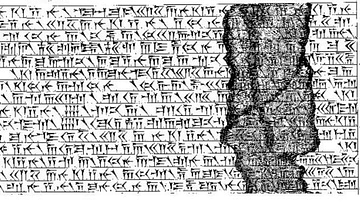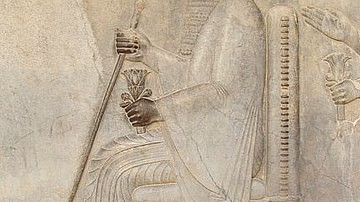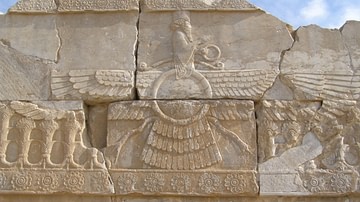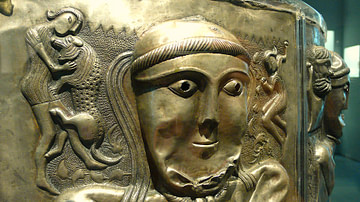Search
Did you mean: Behistun Inscription?
Summary 
Loading AI-generated summary based on World History Encyclopedia articles ...
Search Results

Image
The Behistun Inscription
Darius I's (c. 550-486 BCE) trilingual inscription, in Akkadian or Babylonian, Elamite, and old Persian, carved on the Behistun rock relief from the village of the same name.

Definition
Behistun Inscription
The Behistun Inscription is a relief with accompanying text carved 330 feet (100 meters) up a cliff in Kermanshah Province, Western Iran. The work tells the story of the victory of the Persian king Darius I (the Great, r. 522-486 BCE) over...

Image
Behistun Inscription, Column 1
Behistun Inscription, Column 1 (DB I 1-15)
Sketch: Fr. Spiegel, Die altpers. Keilinschriften, Leipzig

Definition
Cambyses II
Cambyses II (r. 530-522 BCE) was the second king of the Achaemenid Empire. The Greek historian Herodotus portrays Cambyses as a mad king who committed many acts of sacrilege during his stay in Egypt, including the slaying of the sacred Apis...

Definition
Persian Literature
Persian literature differs from the common definition of “literature” in that it is not confined to lyrical compositions, to poetry or imaginative prose, because the central elements of these appear, to greater or lesser degrees, in all the...

Definition
Darius I
Darius I (l. c. 550-486 BCE, r. 522-486 BCE), also known as Darius the Great, was the third Persian King of the Achaemenid Empire. His reign lasted 36 years, from 522 to 486 BCE; during this time the Persian Empire reached its peak. Darius...

Image
Hercules and Aramaic Inscription from Behistoun
According to its Greek inscription, the rock relief representing Hercules at Behistun was carved in 148 BCE , being dedicated to a local Seleucid governor called Kleomenes. The Aramaic inscription says: "In year 164, in the month of Panemos...

Definition
Ahura Mazda
Ahura Mazda (also known as Ahuramazda, Harzoo, Hormazd, Hourmazd, Hurmuz, Ohrmazd, 'Lord' or 'Spirit') is the highest spirit worshipped in Zoroastrianism, the old Mede and ancient Persian mythology which spread across Asia predating Christianity...

Article
The Ancient Celtic Pantheon
The ancient Celtic pantheon consisted of over 400 gods and goddesses who represented everything from rivers to warfare. With perhaps the exception of Lugh, the Celtic gods were not universally worshipped across Iron Age Europe but were very...

Article
Thutmose III's Battle of Megiddo Inscription
The Battle of Megiddo (c. 1457 BCE) is one of the most famous military engagements in history in which Thutmose III (1458-1425 BCE) of Egypt defeated the coalition of subject regions led in rebellion by the kings of Kadesh and Megiddo. The...